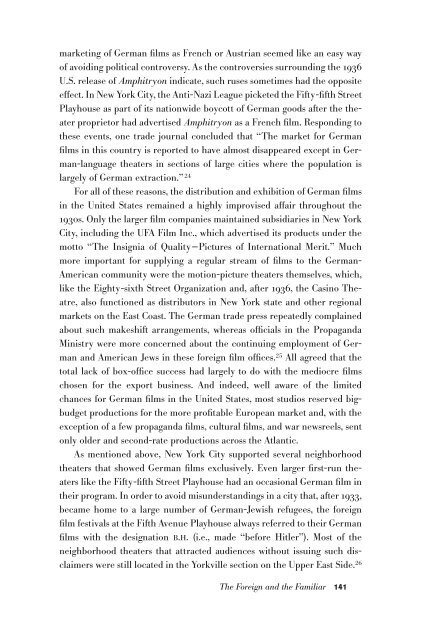Create successful ePaper yourself
Turn your PDF publications into a flip-book with our unique Google optimized e-Paper software.
marketing of German films as French or Austrian seemed like an easy way<br />
of avoiding political controversy. As the controversies surrounding the 1936<br />
U.S. release of Amphitryon indicate, such ruses sometimes had the opposite<br />
effect. In New York City, the Anti-Nazi League picketed the Fifty-fifth Street<br />
Playhouse as part of its nationwide boycott of German goods after the theater<br />
proprietor had advertised Amphitryon as a French film. Responding to<br />
these events, one trade journal concluded that “The market for German<br />
films in this country is reported to have almost disappeared except in German-language<br />
theaters in sections of large cities where the population is<br />
largely of German extraction.” 24<br />
For all of these reasons, the distribution and exhibition of German films<br />
in the United States remained a highly improvised affair throughout the<br />
1930s. Only the larger film companies maintained subsidiaries in New York<br />
City, including the UFA Film Inc., which advertised its products under the<br />
motto “The Insignia of Quality—Pictures of International Merit.” Much<br />
more important for supplying a regular stream of films to the German-<br />
American community were the motion-picture theaters themselves, which,<br />
like the Eighty-sixth Street Organization and, after 1936, the Casino Theatre,<br />
also functioned as distributors in New York state and other regional<br />
markets on the East Coast. The German trade press repeatedly complained<br />
about such makeshift arrangements, whereas officials in the Propaganda<br />
Ministry were more concerned about the continuing employment of German<br />
and American Jews in these foreign film offices. 25 All agreed that the<br />
total lack of box-office success had largely to do with the mediocre films<br />
chosen for the export business. And indeed, well aware of the limited<br />
chances for German films in the United States, most studios reserved bigbudget<br />
productions for the more profitable European market and, with the<br />
exception of a few propaganda films, cultural films, and war newsreels, sent<br />
only older and second-rate productions across the Atlantic.<br />
As mentioned above, New York City supported several neighborhood<br />
theaters that showed German films exclusively. Even larger first-run theaters<br />
like the Fifty-fifth Street Playhouse had an occasional German film in<br />
their program. In order to avoid misunderstandings in a city that, after 1933,<br />
became home to a large number of German-Jewish refugees, the foreign<br />
film festivals at the Fifth Avenue Playhouse always referred to their German<br />
films with the designation B.H. (i.e., made “before Hitler”). Most of the<br />
neighborhood theaters that attracted audiences without issuing such disclaimers<br />
were still located in the Yorkville section on the Upper East Side. 26<br />
The Foreign and the Familiar 141

















